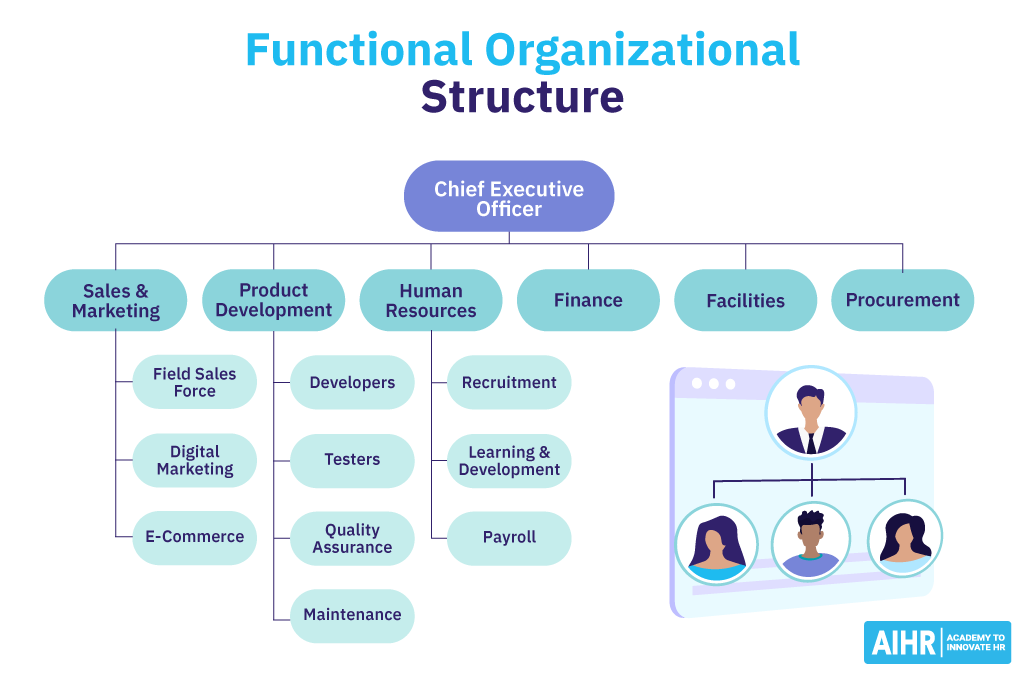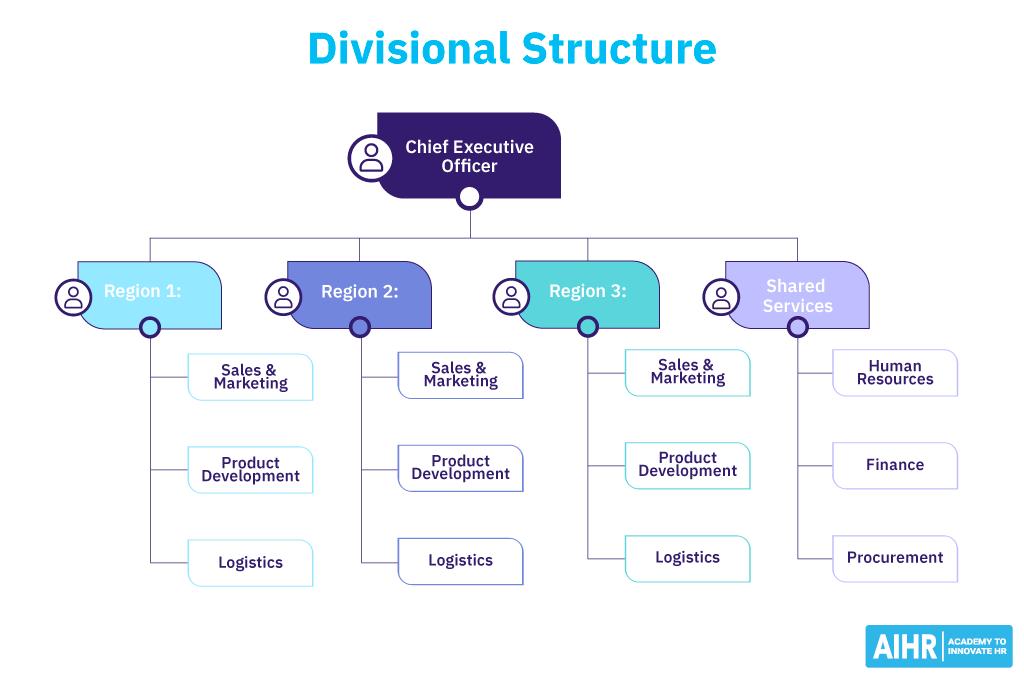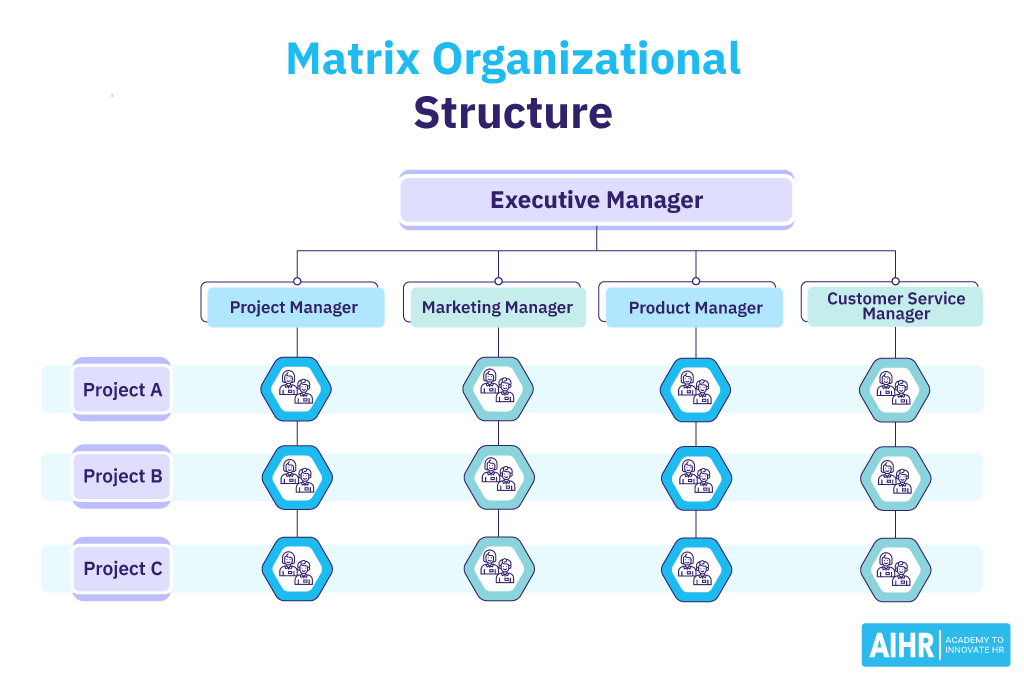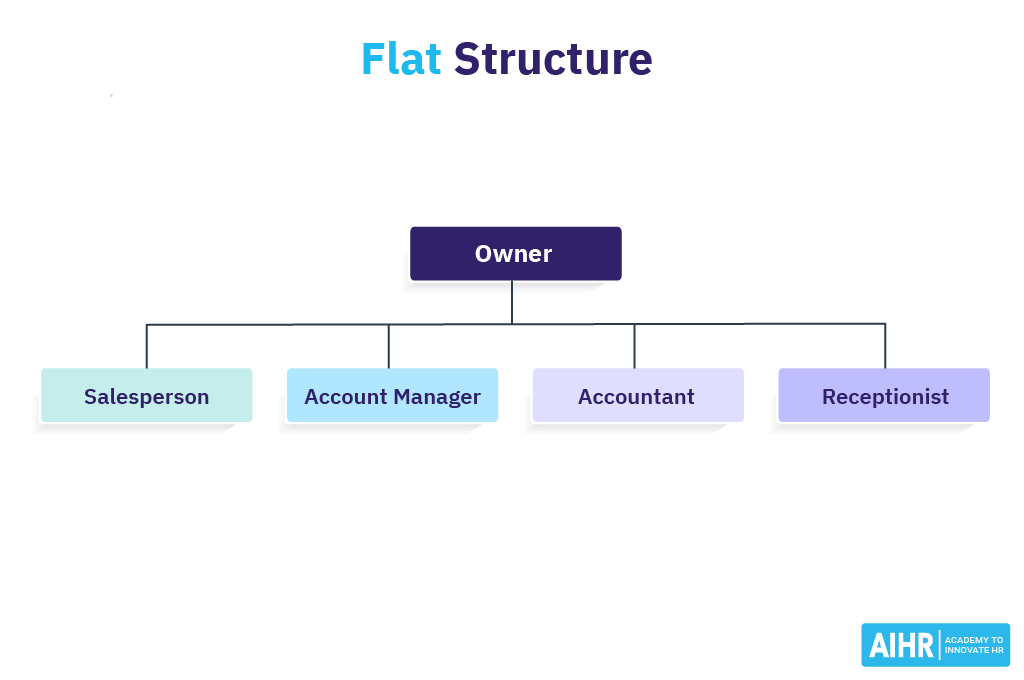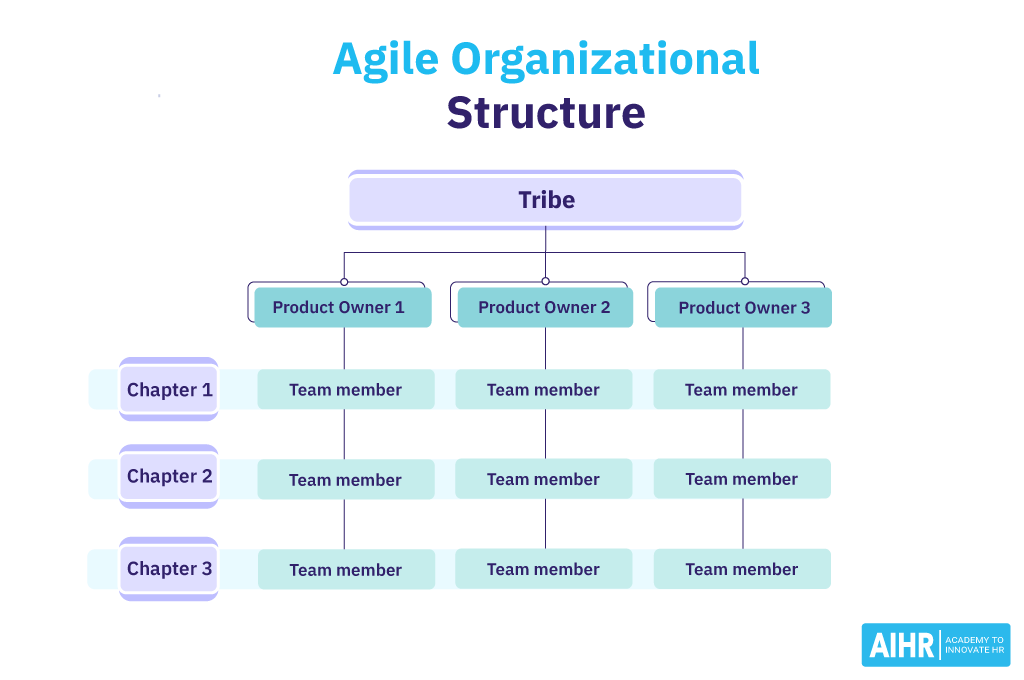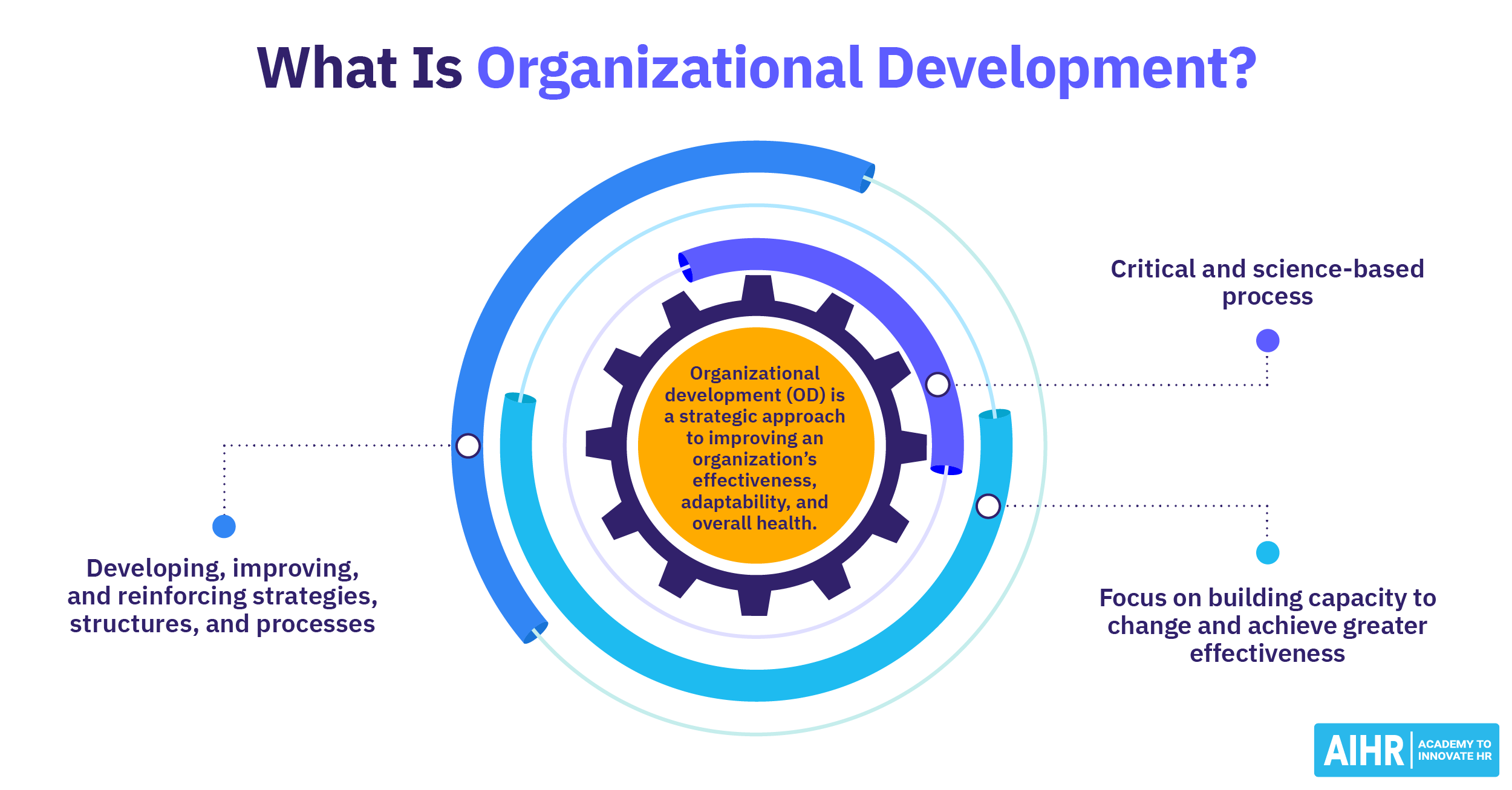Functional Organizational Structure
What is a functional organizational structure?
A functional organizational structure is a form of business organization made up of several departments based on specific skills and areas of expertise. Examples of departments in a functional organization structure could be a human resources (HR) department, marketing department, sales department, finance department, etc.
This type of structure is very common, particularly in large corporations. Some large companies with a functional organizational structure include:
- Starbucks
- Amazon
- Apple.
Understanding how to structure and develop organizations effectively is a key part of Organizational Development. For a step-by-step guide to implementing OD strategies, download our Organizational Development Process Cheat Sheet and start building a more aligned and adaptable organization today.
Characteristics of a functional organizational structure
Some of the most significant characteristics of a functional organizational structure include:
- Departments are organized based on common skills, expertise, and work activities
- Power and decision-making authority are consolidated primarily at the top levels of the organization, with a strong hierarchy-based decision-making style
- Information flows up and down within functional silos, with less cross-functional communication
- Individual departments have clearly defined goals related to their specialized contributions
- Employees develop specialized skill sets and extensive expertise within their specific function.
Functional organizational structure example
Here is a fictional example of an organization that has adopted a functional organizational structure:
TechGenius Inc., which specializes in developing innovative software solutions for businesses, has adopted a functional organizational structure to streamline its operations and enhance efficiency. Here’s how it organizes its structure:
- Sales and Marketing
- Product Development
- Human Resources
- Finance
- Facilities
- Procurement.
In TechGenius Inc., each department specializes in a specific aspect of the business, allowing for greater efficiency and expertise in each functional area. The functional structure facilitates clear lines of communication and responsibility, making it easier to manage large-scale operations.
Functional organizational structure: Advantages and disadvantages
Here are some of the most significant advantages of a functional organizational structure:
- Specialization: By grouping employees based on their function, organizations can cultivate a high level of expertise in specific areas. Prioritizing specialization allows each team member to become an expert in their specific area, enhancing the quality and efficiency of their work.
- Clear reporting structure: This structure provides clear reporting lines and a well-defined management hierarchy. Employees know whom to report to, and managers know whom they are responsible for, simplifying supervision and accountability.
- Clear career paths: Employees have clear career paths within their functional areas, which can help with career development and progression planning.
- Stability and predictability: Functional structures are generally stable and predictable, making it easier to manage long-term planning and day-to-day operations.
- Simplified training process: Training programs that are focused on specific functional areas can be more efficiently designed and implemented, leading to more effective skill development.
- Stronger coordination: Departments in a functional structure are designed to operate independently, which can lead to more streamlined and coordinated efforts within each function.
There are also certain disadvantages to be aware of before implementing this structure in your organization:
- Silos and isolation: Departments in a functional organizational structure often operate in silos, leading to limited communication and collaboration with other departments. This can result in a lack of understanding of broader company goals and reduced synergy across departments.
- Slow decision-making: Centralized decision-making often leads to slower response times, as it requires input and approval from multiple departments. This can be especially problematic in rapidly changing industries where quick decisions are crucial.
- Limited view of organizational goals: Employees in a functional structure might develop a limited view of organizational goals, with departments focused on their own objectives rather than the overall company mission.
- Career path limitations: Employees may find their career paths limited to their specific area of expertise. This means those who want to explore different functions may feel frustrated by the lack of opportunities, and the company might miss out on utilizing its workforce’s diverse talents and perspectives.
- Resistance to change: Functional organizations can be less adaptable to market changes. New ideas may meet resistance from functional units unwilling to stray from tradition.
- Resource allocation issues: In a functional structure, some departments may end up with more resources than needed, while others might be under-resourced. This imbalance can affect the organization’s overall performance and efficiency.
Functional vs. matrix organizational structure
Focus
An organizational structure where employees are grouped based on their function or specialization.
A structure that combines elements of the functional and regional structures, where employees have dual reporting relationships.
Hierarchy
Clear and rigid hierarchical structure.
Complex structure with dual hierarchy (functional and regional-based).
Authority & control
Centralized decision-making, with authority typically residing in the top management of each function.
More complex decision-making and authority structures, which tend to be more decentralized.
Communication
Vertical, following the hierarchy of the organization.
Both vertical and horizontal, facilitating better coordination between different functions.
Suitability
Best suited for organizations with stable and predictable environments, where work and processes are repeatable and uniform over time.
Ideal for dynamic and complex environments, especially where cross-functional collaboration is crucial.
Functional vs. divisional organizational structure
A functional organizational structure groups employees by job functions (e.g., marketing, finance) and centralizes decision-making, leading to specialization and efficiency within departments. However, it can create communication silos and result in slow decision-making due to its hierarchical nature.
In contrast, a divisional structure organizes employees based on products, services, or regions, allowing divisions to operate semi-independently with decentralized decision-making. This structure enhances flexibility, responsiveness, and market focus but can lead to resource duplication, internal competition, and complex management.
The choice between these structures depends on a company’s size, complexity, and strategic goals. Larger, diverse companies may benefit from a divisional approach, while smaller, specialized firms might prefer a functional structure for efficiency.
4 other types of organizational structures
There are other types of organizational structures besides the functional organizational structure. Let’s take a look at four of them:
1. Divisional or regional structure
A divisional structure divides an organization into semi-autonomous units, each responsible for a product, service, or geographic area. This structure is common in large corporations with diverse product lines or different markets.
- Benefits: Strong focus on localization of requirements to market, allows for more flexibility in execution and faster-decentralized decision-making.
- Limitations: Can result in duplication; difficult to drive standardization.
Companies that use this structure: McDonald’s, Disney
2. Matrix organizational structure
A matrix structure combines elements of the functional organizational structure with elements of the divisional structure. Each employee reports to two bosses: one for their functional area (like marketing or finance) and one for their product or project.
- Benefits: Drives cross-disciplinary collaboration, shares expertise across the organization, and, if managed well, drives innovation.
- Limitations: Often internally focused and requires clear governance to work; internal tensions in terms of conflicting priorities and accountability.
Companies that use this structure: Nike, Philips
3. Flatarchy
This flat organizational structure has few or no levels of middle management between staff and executives, encouraging open communication and collaboration.
- Benefits: Drives ownership and accountability, makes collaboration easier.
- Limitations: Often struggles to differentiate between strategic and operational work; resource allocation can be too thinly spread across areas; Could slow down decision-making due to the need to seek consensus.
Companies that use this structure: Valve, Buffer
4. Team-based or agile structure
This structure is organized into project teams that often function autonomously, working towards specific goals.
- Benefits: Leverages cross-functional capacity; more flexible in allocating resources.
- Limitations: Decision-making and resource allocation are not always clear; can result in fragmented work practices and lack of consistency.
Companies that use this structure: Spotify, Airbnb
FAQ
A functional organizational structure is a type of organizational design where a company is divided into specialized departments or units based on specific functions or roles, such as marketing, finance, production, and human resources. Each department is managed by a functional manager who oversees activities and performance within that function, ensuring expertise and efficiency in specific areas.
The four types of organizational structure are:
• Functional structure: Organizes employees based on specialized roles or functions, such as marketing, finance, and production.
• Divisional structure: Groups employees based on product lines, geographical locations, or customer markets.
• Matrix structure: Combines functional and divisional structures, with employees reporting to both a functional manager and a project or product manager.
• Flat structure: Features few or no levels of middle management, promoting a more decentralized and flexible approach to decision-making.
While a functional organizational structure suits many types of businesses, an overemphasis on specialization can lead to an overall lack of communication and collaboration among different departments. This hinders effective decision-making that benefits the entire company and can impact individual team members’ understanding of their role in a broader business context.
Organizations where operations are relatively stable, and tasks are highly specialized tend to function well within this structure. It’s particularly effective for larger companies or those in industries where technical proficiency and routine procedures are key, such as manufacturing, accounting, or law firms. In these settings, clearly defined roles and responsibilities enable efficient task execution and facilitate specialized skills development.





